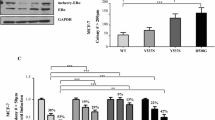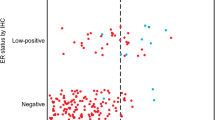Summary
Evidence to date indicates that structurally abnormal estrogen receptor (variant ER) can be detected in some human breast tumors. Based onin vitro ability to bind DNA sequences containing the cognate estrogen response element (ERE), these variant receptors may be categorized into DNA-binding ER (Type-1 variants) and non-DNA-binding ER (Type-2 variants). To look for Type-2 variants of normal size (67 kDa ER) that lack the ability to form immunoreactive ER-ERE complexes, a panel of 40 cryopreserved primary breast tumors were extracted and analyzed by enzyme immunoassay (ER-EIA), gel-shift, and Western blot techniques. For the 33 tumor extracts containing ≥10 fmol/mg ER (by ER-EIA), the amount of 67 kDa ER detectable by D75 anti-ER monoclonal antibody under fully denatured and reduced assay conditions (Western blotting) did not correlate well with the presence or intensity of D75 immunoreactive ER-ERE bands seen under native conditions by gel-shift assay. Overall, 30% (10 of 33) of these extracts containing 67 kDa ER failed to produce immunoreactive ER-ERE complexes, with this frequency varying from over 40% in tumor samples with lower ER content (10-49 fmol/mg) to 11% in tumor samples with the highest ER content (>100 fmol/mg). These results indicate that Type-2 variant receptors characterized as non-DNA-binding 67 kDa ER may be present in a significant fraction of ER-positive primary breast tumors; preliminary evidence suggests that further study of abnormalities in ER tertiary or quaternary structure, such as those produced by intracellular oxidation of ER thiol groups, is warranted.
Similar content being viewed by others
References
McGuire WL: Steroid hormone receptors in breast cancer treatment strategy. Recent Prog Horm Res 36: 135–156, 1980
Beato M: Gene regulation by steroid hormones. Cell 56:335–344, 1989
Fuller PJ: The steroid receptor superfamily: mechanisms of diversity. FASEB J 5:3092–3099, 1991
Fuqua SAW, Fitzgerald SD, Chamness GC, Tandon AK, McDonnell DP, Nawaz Z, O'Malley BW, McGuire WL: Variant human breast tumor estrogen receptor with constitutive transcriptional activity. Cancer Res 51:105–109, 1991
Fuqua SAW, Fitzgerald SD, Allred DC, Elledge RM, Nawaz Z, McDonnell, O'Malley BW, Greene GL, McGuire WL: Inhibition of estrogen receptor action by a naturally occurring variant in human breast tumors. Cancer Res 52:483–486, 1992
Scott GK, Kushner P, Vigne J-L, Benz CC: Truncated forms of DNA-binding estrogen receptors in human breast cancer. J Clin Invest 88:700–706, 1991
Greene GL, Sobel NJ, King WJ, Jensen EV: Immunochemical studies of estrogen receptors. J Steroid Biochem 20:51–56, 1984
McCarty KS, Grant JW, Georgiade N, Wilkinson W, Graham R, Ferguson B, Deubner D, McCarty KS, Seigler HF: Immunoglobulin localization in benign and malignant lesions of the human mammary gland. Cancer 48:69–75, 1981
Borkowski A, Gyling M, Muquardt C, Body JJ, Leclercq G: Estrogen-like activity of a subpopulation of natural anti estrogen receptor autoantibodies in man. Endocrinology 128:3283–3292, 1991
MacDonald RG, Leavitt WW: Reduced sulfhydryl groups are required for activation of uterine progesterone receptor. Possible involvement of an inhibitor of activation. J Biol Chem 257:311–315, 1982
Peleg S, Schrader WT, O'Malley BW: Sulfhydryl group content of chicken progesterone receptor: effect of oxidation on DNA binding activity. Biochemistry 27:358–367, 1988
Peleg S, Schrader WT, O'Malley BW: Differential sensitivity of chicken progesterone receptor forms to sulfhydryl reactive reagents. Biochem 28:7373–7379, 1989
Pike JW: Evidence for a reactive sulphydryl in the DNA binding domain of the 1,25-dihydroxyvitamin D3 receptor. Biochem Biophys Res Commun 100:1713–1719, 1981
Coty WA, Klooster TA, Griest RE, Profita JA: Resolution of the effects of sulfhydryl-blocking reagents on hormone- and DNA-binding activities of the chick oviduct progesterone receptor. Arch Biochem Biophys 225:748–757, 1983
Weinberger C, Hollenberg SM, Rosenfeld MG, Evans RM: Domain structure of human glucocorticoid receptor and its relationship to the v-erb-A oncogene product. Nature 318:670–672, 1985
Miesfeld R, Rusconi S, Godowski PF, Maler BA, Okret S, Wikström AC, Gustafsson JA, Yamamoto KR: Genetic complementation of a glucocorticoid receptor deficiency by expression of cloned receptor cDNA. Cell 46:389–399, 1986
Luisi BF, Xu WX, Otwinowski Z, Freedman LP, Yamamoto KR, Sigler PB: Crystallographic analysis of the interaction of the glucocorticoid receptor with DNA. Nature 352:497–506, 1991
Grippo JF, Holmgren A, Pratt WB: Proof that the endogenous, heat-stable glucocorticoid receptoractivatingfactor is thioredoxin. J Biol Chem 260: 93–97, 1985
Silva CM, Cidlowski JA: Direct evidence for intra- and intermolecular disulfide bond formation in the human glucocorticoid receptor. J Biol Chem 264:6638–6647, 1989
Author information
Authors and Affiliations
Rights and permissions
About this article
Cite this article
Montgomery, P.A., Scott, G.K., Luce, M.C. et al. Human breast tumors containing non-DNA-binding immunoreactive (67 kDa) estrogen receptor. Breast Cancer Res Tr 26, 181–189 (1993). https://doi.org/10.1007/BF00689691
Issue Date:
DOI: https://doi.org/10.1007/BF00689691




